The Ultimate Guide for Collecting and Using Testimonials

Testimonials are the most powerful marketing and sales tool.
"I don’t know how I survived without this before" — Charlie Customer
Quotation marks, a few words and a name — and you’ve got yourself an ad more powerful than your copywriter could ever dream to create. And your customer did it for you!
That’s the brilliance of client testimonials: powerful words supplied by the customers themselves and made believable by virtue of social proof.
Customer testimonials are your opportunity to let your customers do your marketing for you.
And they’re not just words. They’re also videos, five-star ratings, before-and-after photos. There’s a format for every imaginable use. And they've been proven to work.
In this guide, we'll walk you through testimonials and explain how to use testimonials effectively instead of just posting a company logo of your biggest customer on your website.
Continue reading to learn:
- What testimonials are
- Why testimonials work (with evidence to back it up)
- How you can create text and video testimonials
- How to utilize video, audio, text and photos to supercharge your success story section on your website
Let's get to it.
1. Defining Testimonials
Customer testimonials are the honest words of your happiest customers telling everyone why you rock.
Customer testimonials tell the real stories of your customers. The stories of how once upon a time someone just like you had a problem, searched for a solution, found a product, took a chance with it and ended up falling in love with it.
More technically, a testimonial is a snippet of text, video or audio used for marketing purposes in which a satisfied customer shares their experience with a product or service and recommends it to the reader/viewer/listener. In other words, there are many words for testimonials in the marketing context and they sometimes overlap in meaning.
Let's take a look at one:
Let me ask you something. How did watching that make you feel?
I'm guessing: positive, but in a casual everyday kind of way. And that's exactly why testimonials are so brilliant:
Words of unblushing praise that still manage to come across as casual and relatable. Those are the main ingredients of effective testimonials.
A copywriter wouldn't get away with this: their words would be seen as untrustworthy. But since testimonials come from real clients, they are trusted. In fact, 72% of people say that they trust a business more after reading positive testimonials and reviews about it.
This is called social proof. It’s people's natural reliance on their peers' judgment to show them how to act in new situations.
Testimonials vs Reviews
Are testimonials and reviews the same thing? Not exactly. There’s a huge underlying difference.
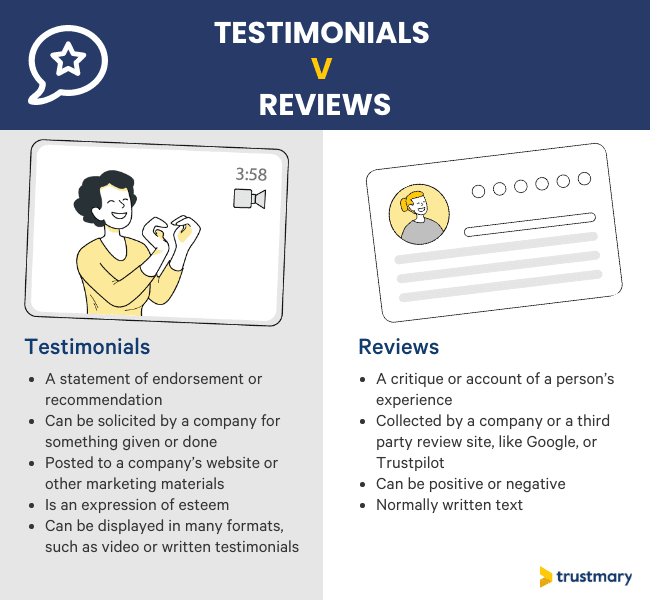
Reviews are customers' honest thoughts on their purchase, positive or negative, shared spontaneously. You know, the ones you see on Google Maps for restaurants or on Amazon for any gadget.
Testimonials, on the other hand, are exclusively positive customer stories collected specifically for marketing purposes. They can simply be picked out from a bunch of reviews or they can be requested from the customers on the company's own initiative.
This example is from Acon’s website. This is an excellent example of how reviews can also be testimonials. However, the last one written by Benjamin counts only as a review, as it contains some negative aspects as well.
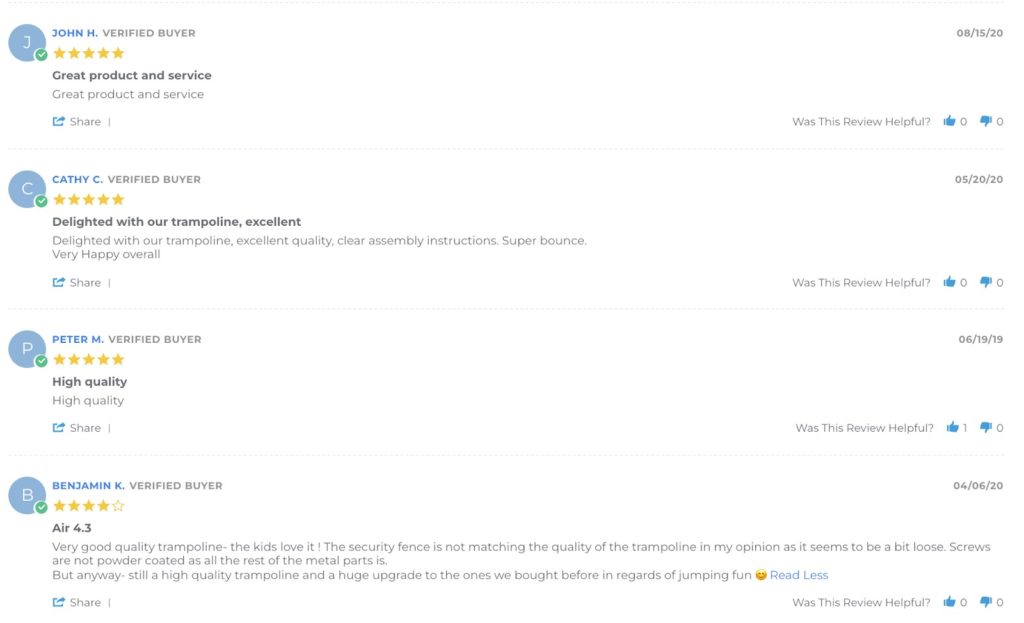
Testimonials are much more than just positive words by your customers. They are actually incredibly versatile. Let’s look into that next.
Different Types of Testimonials
When we talk about testimonials, we tend to think of those glowing words together with 5 stars somewhere at the bottom of a web page. In the B2B context, testimonials are mostly quotes from customers accompanied with their name, photo, title, and the company they work for.
But they’re actually much more than that. They range from a few words to longer testimonials.
Testimonials can be:
- Videos
- In-depth case studies
- Case stories as a blog post
- Interview testimonials (can be podcasts, articles, or a part of a webinar)
- Social testimonials (tweets, videos on Youtube or TikTok, Facebook and Instagram posts)
- Influencer testimonials (=paid collaborations)
- Quotes
- Or a combination of all of these
Here’s one example of a testimonial page from Staria:
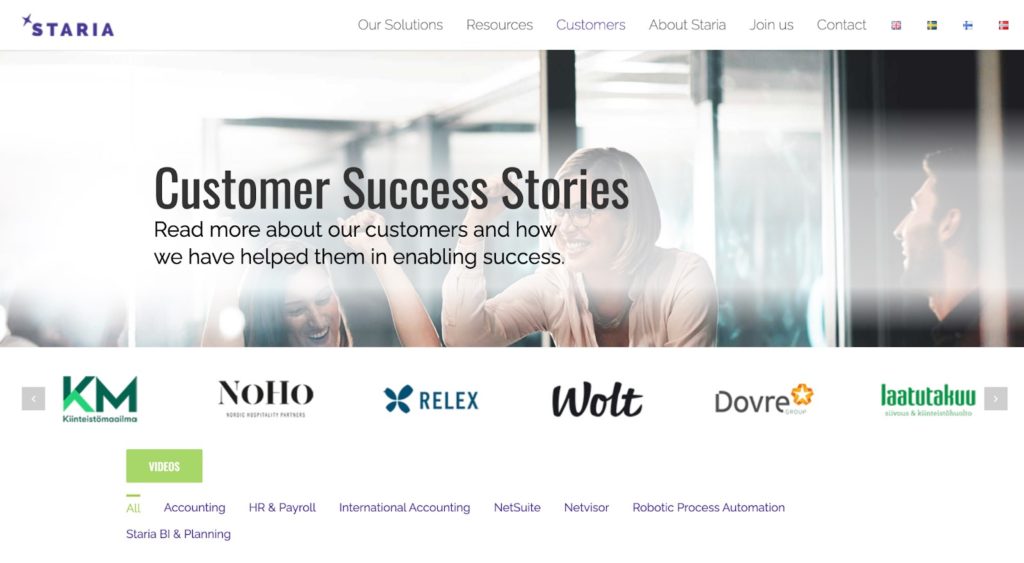
When you enter their “Customers'' page, you can see that they have included their biggest customers’ logos to boost trust. Furthermore, they’ve benchmarked their ideal target market sections and let you easily filter the relevant ones for each user.
Did you notice that green “Videos” CTA there? If you have video testimonials, highlight them because they’re easily your best testimonials in terms of conversions. According to Forbes, videos were already in 2010 becoming the critical information source for senior executives.
In 2024, the importance of testimonials is even more highlighted, as we don't meet people face-to-face as much as we used to. Give your potential customers the information they crave for: Show them you can be trusted.
Place your best testimonials everywhere: on front pages, landing pages, dedicated testimonial pages, exit popups, blog posts, outreach emails, social media channels, as a blog post, as a QR code on a lamppost on a street, or even on your physical sales presentation booklet.
You can even create a dedicated testimonial page just to show them off. Or add them as widgets to boost conversions.
The use cases for testimonials are numerous. They can be used in both marketing and sales at any point of the sales funnel. They can be the first thing that captures your potential customers' attention, and they can just as well be the final thing that gets them to finalize their purchase on your website.
If that didn’t convince you of the importance of testimonials, let’s have a look at some statistics to further prove their meaning.
2. Importance of Testimonials
Here’s some hard data to convince you that you need to start using testimonials.
92% of consumers read online reviews and testimonials when considering a purchase.
95% of consumers say that reviews — both negative and positive — influence their buying decisions.
88% of consumers trust online reviews as much as they trust recommendations from a friend.
What do marketers think?
Well, 89% of marketers say that customer testimonials have the highest effectiveness rating for content marketing. In other words, a good testimonial is one of your most powerful marketing materials.
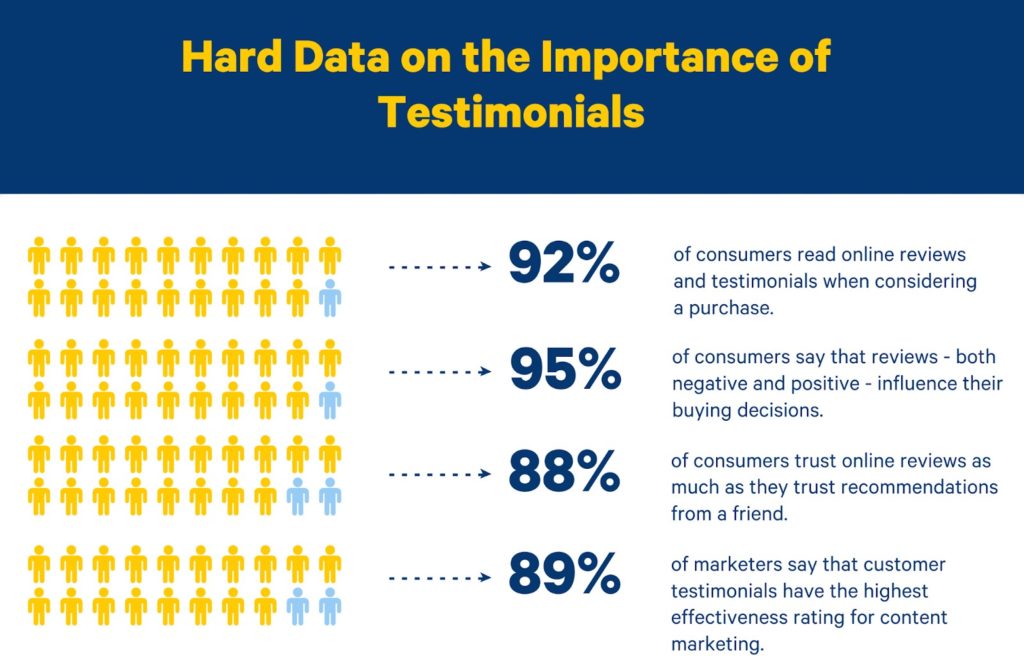
Real Life Case Stories
We have been in the testimonial business for many years, and have noticed the effects of testimonials numerous times.
Here are some of the tangible results we have documented:
- Ruokaboksi: 37% More Sales with A Pop-Up with Reviews
- Case Kattotutka: Over 60% Increase in Contact Requests
- Eurokangas: 38,52% Improvement in Purchase Journey with Reviews
- Satokausikalenteri: 20% More Sales With Video Reviews
Like we see from the examples, testimonials are extremely important for all kinds of companies in all kinds of industries: realtors, fitness instructors, professional services, freelancers, contractors, online stores, hotels, and healthcare providers all need testimonials.
We’ve now established that:
- People care about what other people have to say about a product or a service
- Marketers have found testimonials to be very useful in increasing conversion rates and generating leads
That’s what we’ll show you in the next chapter. Or if you’re busy to get started right away, start using Trustmary, the best testimonial software there is, for free.
How to Gather Testimonials (with Examples!)
There are two primary ways of gathering testimonials:
- Look for existing testimonials all over the internet.
- Ask your happy customers to provide you with one.
Option 1 skips the need to create a new testimonial, and instead taps into the existing testimonials all over the internet. However, this method runs into a number of challenges, such as obtaining permission to use the testimonial as well as the quality and relevance of the testimonial for your purposes.
Option 2 has you reaching out to satisfied customers who might be willing to create a testimonial. You reach out, guide them through the process, and do the necessary production work. May seem cumbersome, but it’s actually surprisingly easy and gets you extremely valuable testimonials that are laser-focused on exactly the themes that matter.
Both options have their pros and cons, but there's one thing that is true to both:
Trustmary is the easiest way to collect both of them.
It allows you to:
- Import reviews and testimonials from the biggest review sites (Capterra, Trustpilot, Yelp, G2, Google, and more)
- Automate the process of constantly collecting testimonials by offering you integrations to your CRM (such as Hubspot and Pipedrive).
Next, let's look at the details of the different ways of getting those customer stories.
Look for Existing Testimonials
There might already be testimonials on the internet about your business – especially if you have managed to exceed a customer's experiences.
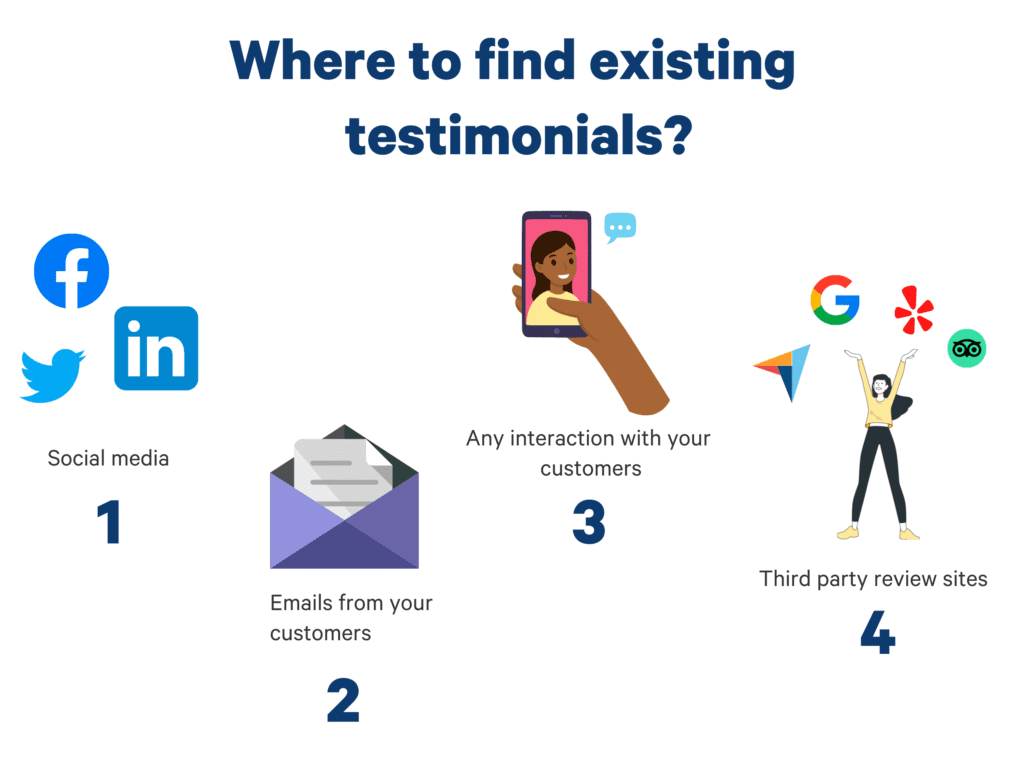
Let's look at them in more detail.
1. Social media
Social media channels are a goldmine for finding customer feedback, including raving testimonials that aren’t overly formal.
People love social media, and they go there not just to observe; they go there to be social, to participate.
That means voicing their opinion, sharing recommendations and tips, complaining and venting. If your product is good or you always provide excellent service, you'll most likely find great testimonials on social media.
You can find these by simply doing Google searches for your brand name or doing a search on the given social media platforms. You can also utilize various social media monitoring tools that analyze what's happening in your social media. The social media platforms' own analytics tools may be useful too.
The problem with getting new testimonials from social media is that:
- People might have a private account so you’re unaware of possibly your best advocates
- You have to ask for permission to use the content separately from each individual.
2. Emails from Customers
You probably engage in some sort of email correspondence with your customers. These emails often contain spontaneous praise of you that you could utilize in your marketing if you had the permission to use it publicly.
If a customer spontaneously sends you an email thanking you for a lifesaving product, the praise is self-evident.
But even if they're reaching out to you just to inquire about your shipping methods, you may be surprised at what brilliant copywriting they're giving you free of charge:
"Thanks so much! You guys have the best customer service on the planet!"
See? Testimonials are everywhere! Again, you have to ask whether you can post that publicly or not. I mean, how many times have you already wondered whether you could use this or that quote on your website, but are simply too shy to ask your customer for permission?
3. Any Encounter with Customers — We Mean Any
In-person encounters; physical thank you notes from your most dedicated customers; phone calls. Any encounter with your customer may yield words of praise that you can use for marketing. Keep your eyes and ears open.
4. Third-Party Review Platforms (Trustpilot, Google, Yelp etc.)
Third-party review platforms are an obvious source of testimonials. A huge amount of reviews inevitably contains many positive reviews suitable for marketing use.
The usual way to incorporate reviews from these platforms into your marketing is simply to use a widget to embed the reviews as they are onto your website.
Bottom Line: Testimonials Are Everywhere but You Can Run Into Legal Issues
The bottom line is that there are plenty of words of praise out there just waiting to be seen. It’s incredibly effective marketing-wise to have even a short testimonial written by a real person.
But using those testimonials is another thing. Most of the time, if a customer has mentioned and tagged you on a social media post, it would be perfectly acceptable to share that mention on your own social media channel.
But what about bringing the comment outside of said platform? Can you use it on your website or email campaigns? Perhaps not. That's where the difficulty starts.
Ask for Testimonials
Yes. You can also just ask for them. If you're struggling with it, these 7 actionable ways to get testimonials from your customers will help.
This is actually the better way to do it if powerful, focused testimonials are what you are looking for. Statistically speaking, 72% of people will write a review if you ask for one.
Asking a stranger for a favor understandably feels a bit awkward.
But here's the thing: they're not strangers. They're your customers, and most importantly, they're your HAPPY customers. I mean, you're not reaching out to your dissatisfied customers for a testimonial.
Take a look at this:
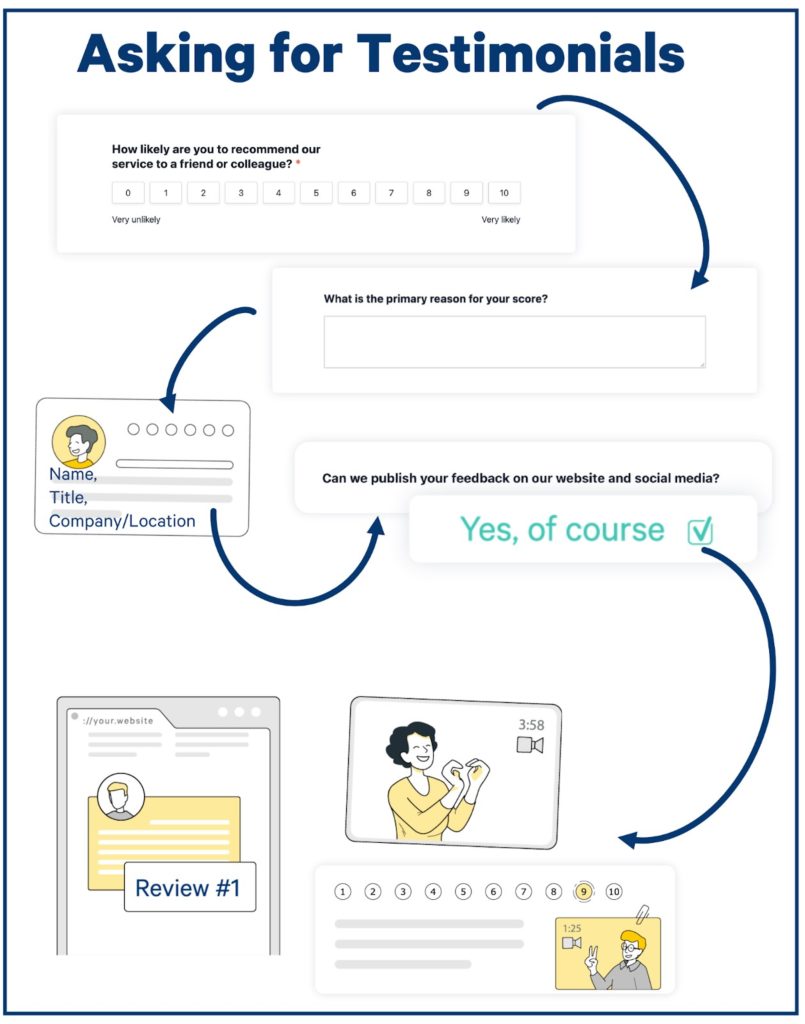
The above image shows how you can create branched surveys for asking for testimonials. If a customer indicates their satisfaction with a high rating (like NPS or star rating), you can next ask for their testimonial. If they seem to be unhappy, they can leave constructive private feedback instead.
Doesn't seem so difficult anymore, does it?
Your happiest customers already love you and your product, and they have great things to say about you in their minds. Many of them will be willing to share with the public what they think as long as you approach them in a gentle and polite manner, encourage them a bit, and make the process easy for them.
You'd be surprised but people actually are frequently willing to appear even on a VIDEO testimonial just by asking them! (With Trustmary, you can also get video testimonials. Just saying.)
Now that we've gotten over the fear of asking for a testimonial, let's look at some other practical ways to do this.
1. Email
Email is one of the most practical ways of getting your customers to write or record a testimonial — even a video.
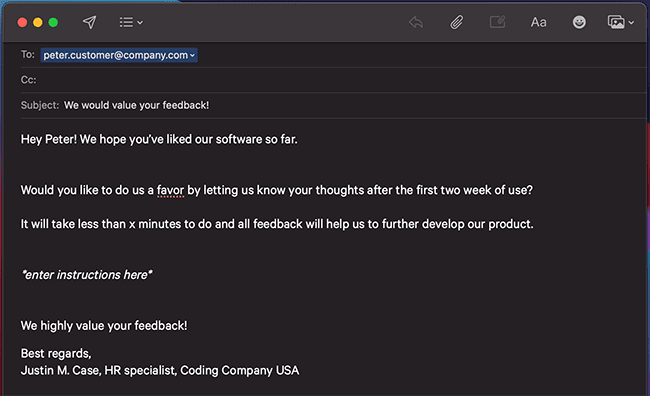
The basic template is as follows:
- A friendly greeting with something personal about the customer
- “Hey Peter! We hope you’ve liked our software so far.”
- Ask them if they'd like to give their thoughts
- “Would you like to do us a favor by letting us know your thoughts after the first two week of use?”
- Ensure them that it's easy and quick and that they can't do it wrong
- “It will take less than x minutes to do and all feedback will help us to further develop our product”
- Step-by-step instructions and guidance (as easy as possible!)
- A thank you
- “We highly value your feedback!”
Email is great because it's so versatile and easy to use. You can tailor personalized messages to different customer segments or even individual customers or automate the whole process. There are software tools, such as Trustmary, that allow for efficient automated email requests using ready-made templates.
2. SMS
Sending an SMS or using WhatsApp to request a testimonial works largely in the same way as email, but remember to keep the message shorter and simpler. Just get to the point and give them a link to giving the testimonial.
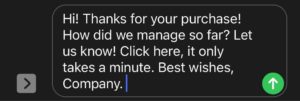
The most effective way to get good testimonials via SMS is to send the request right after they visited your location or bought something from you. If you send out automated mass SMS’, make sure that you’re sending it at the appropriate time, and not, for example, in the middle of the night.
Using a dedicated business phone number for SMS marketing ensures that messages remain professional, organized, and easily managed.
3. Website
Your website is one of the places to collect testimonials from.
The challenge with the website form is that:
- You might not be able to control who leaves a review and if they are a legit customer.
- The customer might not have seen enough to be able to review their experience (of course depending on your business).
Website testimonial collection makes sense if you want to get testimonials from an online shopping experience right after the checkout, or maybe if you provide an online service or digital product, and ask for a testimonial right after the service takes place.
5. QR code
QR codes can be placed anywhere in your physical location and on brochures. They are an efficient way to direct people directly to your review form.
A newer alternative for QR codes is NFC stands, which work like contactless payments in the supermarket. You just tap your mobile device on the stand and it will show the testimonial form.
6. Social media
You can encourage people to tell their experiences from their own perspective on your different social media platforms.
It might be a good idea to show them testimonial examples of what your company considers to be a good testimonial. In case you have really specific features in your product of service, make sure to mention that you are looking for feedback on them specifically.
That being said, encourage people to be as genuine as possible. Their comments should come from the heart instead of sounding like a written interview.
Remember to thank for each comment you get! You can consider launching a giveaway campaign where you giveaway something once you’ve received a certain amount of testimonials.
7. Personally (face to face, call)
Making personal requests might be a little too time-consuming (and it’s most definitely not cost effective), if you’re looking for getting even dozens of quote testimonials for your business.
However, if you’re starting from scratch, being personally in touch with your happy customers can be a good place to start collecting the first ones. After having a handful of testimonials, you can start using them as examples to get some more.
At the same time when you’re collecting testimonials, you can have some really meaningful conversations with your customers about why they’re using your services in the first place.
Additional Tips on Asking for Testimonials
If you’re trying to get glowing testimonials of your product or service, be precise in phrasing your testimonial request to be exactly what you want.
Here are the 3 Best Examples of Testimonial Request Letters That You Can Copy as well as the 15 questions you should ask!
If you want versatile testimonials that talk about your specific products, services, or aspects of the experience, ask different customers to share their positive experience on each factor separately. Share alongside with your request some testimonial examples that others have provided you to be really specific.
You can also integrate testimonial request in your feedback process. That's what we can help you with. Check out what others have achieved:
- Jeda Logistics: 69 Testimonials, 19 Google Reviews in 3 Months
- Glass Factory: 3-in-1 Survey 👉🏻 20% Response Rate to Survey & 50 Testimonials
What next?
Many companies aren’t using their most powerful tool, customer testimonial, to the fullest. Think about it like this: If all your future customers were to look at your testimonial page right now, would that buy them over? Or would they rather go to your competitor?
The fitness industry is a great example of a branch that has really nailed how to use quote testimonials, influencer testimonials, and a great success story to their benefit. Have a look at fitness testimonial examples you can get inspired by!
Having at least one customer testimonial is a start. Having positive feedback (and even some negative reviews) for each of your product or service components will, however, boost your growth in ways you cannot even imagine.
4. Best Ways to Use Testimonials in Marketing
Because testimonials come in so many shapes (text, video, audio) and sizes (short and long form) they are suitable for many different marketing channels.
Also, their utilization of social proof makes them relatable and suitable for situations where more traditional salesy and pushy marketing wouldn’t be appreciated.
Let’s cut to the chase.
Social Media Paid Ads
Testimonials are a particularly good fit for social media.
Consider this: as explained in a previous chapter, social media is an excellent source of testimonials, as that's what people do there — share their experiences.
This naturally means that social media is also the perfect platform for publishing the customer stories you've procured yourself. It's the perfect platform, because the testimonials naturally popup there anyway, as people are telling about the good and bad service they’ve got.
Testimonials and social media really are a match made in heaven. Try adding testimonials on LinkedIn ad campaigns – and organically posted as well. That'll surely move the needle.
Basically, only your imagination is the limit. You can use text, video, star ratings, images, and even case study testimonials, whatever you want. Add explanatory text or just leave as it is. If you're demonstrating something visually, an online screen recorder can help capture and showcase it effectively.
Remember to keep the message short. Two or three paragraphs are a often the maximum, where the sentences are short, on-point and each carry a powerful message.
TV
I know what you're thinking. TV is for the big-budget productions — cinematic ads of German cars and Swiss watches.
This is partially true, but not completely. There's plenty of advertising on television that also tries to be relatable and authentic, not too Hollywoody. Yet the advertising often fails, because it looks — well, like an ad.
A video testimonial fixes this problem. It looks real because it is real.
Influencer Testimonials
There are a lot of influencers nowadays that will advertise your product or service on their platform. It can be anything from Instagram to their blog post to creating a whole video series around your brand.
The great thing about influencer marketing is that you get to tap into the followers the influencers already have. However, you need to choose the right influencer to promote your product in order for it to be beneficial for you.
For example, Wello2 is a great example of a company that has tapped into the influencer testimonial game by getting a famous musician, Bernie Shaw from Uriah Deep, to recommend their product on a video. It’s clearly shot with an extremely low budget and Shaw is speaking freely and not acting.
With this material, the product can be further marketed to other musicians.
You can see the short video here.

An easy way to try out influencer marketing is to try to find micro-influencers that have a very niche audience that is also the key customer profile for your company.
Recently, I’ve noticed that many Youtubers have done collaborations with different brands. One great example is Scrub Daddy that produces cleaning products that has started to work together with an extremely popular Finnish youtuber, Aurikatariina, who cleans people’s extremely messy apartments for free.
Aurikatariina cleans to help out people that are in dire need of help, and the apartments are filthy. She has used Scrub Daddy’s products for a long time already, but has since their official collaboration started to clearly highlight different products she uses.

Her channel on Youtube has 4,28 million subscribers and her TikTok account has 11,7 million followers. Those are people who are inspired to clean thanks to her cleaning. And it’s not hard to guess which products her followers are using to clean.
Radio
Audio testimonials are a thing too. To hear the excited voice of a real customer instead of the company's salesperson or of a famous broadcasting voice adds credibility and is sure to get the attention of the listeners' ears.
On website
People who end up on your website are most likely interested in your offerings, but not necessarily ready to buy yet. They may be in the early stages of consideration: weighing the pros and cons, and looking for evidence.
Enter testimonials: a carefully placed, relevant testimonial may serve as an incredibly powerful decision-making factor in the purchase process.
Good places on your website for testimonials include:
- Home page for any casual browser
- Dedicated testimonials page for the diligent researcher
- Landing page or product page to be ultra-relevant to the visitor (try these pretty and branded testimonial carousels!)
- Checkout page or pricing page to convince the almost-decided buyer to finalize the purchase
- Next to CTAs to function as supporting copy
- Exit intent popup to remind the uninterested that you're the real deal
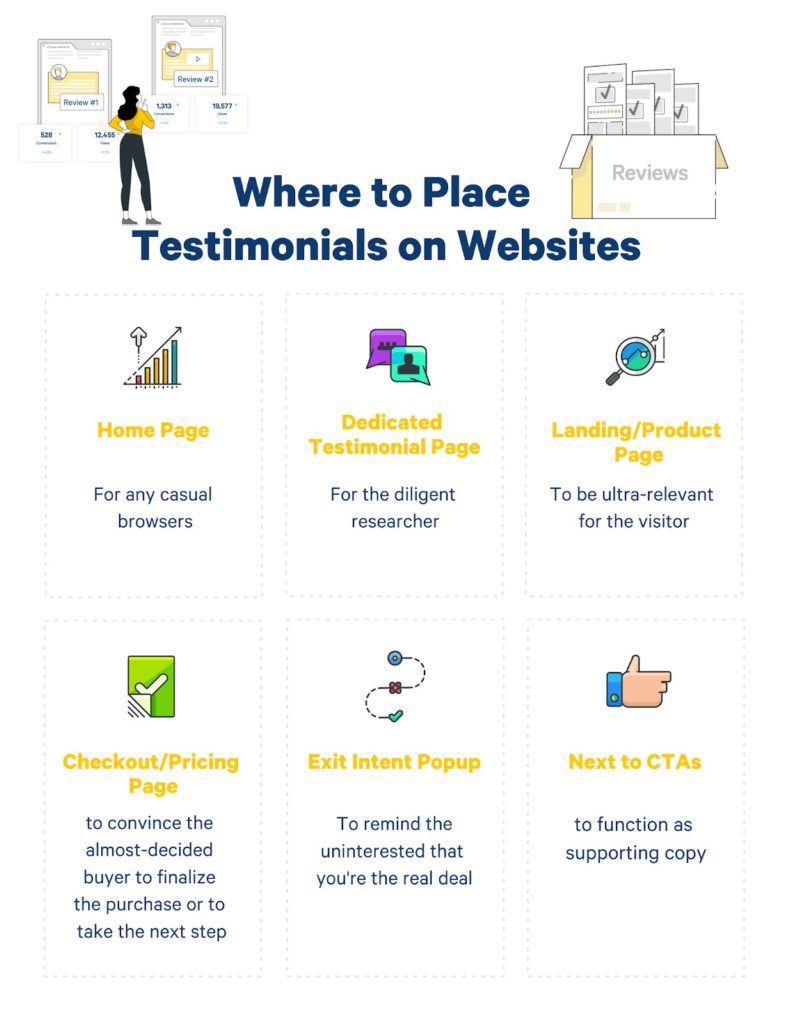
You can also utilize your website's analytics to see where people spend time and consider adding a testimonial there. A/B and multivariate testing are key here.
In Blogging and Content Marketing
The content you publish can be a good spot to feature a testimonial in.
As mentioned before, social media is a natural medium for testimonials. You may incorporate testimonials of various kinds, including lengthy case studies into your social media posts.
Your content on your website can also feature testimonials. Consider writing case studies as blog articles or incorporating a quote testimonial as a part of a longer blog post.
Users of Squarespace, WordPress, and Shopify – We've got a treat for you.
It's very easy to add testimonials to website, whether you use WordPress, Squarespace, Shopify, Wix, or any other popular platform.
We've compared 10 best testimonial plugins for WordPress and 8 different testimonial types. Just so you don't have to go through the trouble.
But we didn't stop there. We wanted to make it as easy as possible to add customer testimonials. So, if you use Squarespace, you can even add testimonials easily to your blog with five simple steps.
We've also compiled 6 effective ways to use testimonials in Squarespace.
Shopify users can also easily add reviews and testimonials to boost their sales.
More and Newer Testimonials Do the Trick
The more testimonials you have, the better. Unfortunately, that’s still not enough. You need to constantly figure out better ways to reach your target audience with the right message that speaks directly to them.
At this very moment, your future customers are looking for someone to fix their problem. Make it easy for them to:
- Find you
- Make the purchasing decision by providing them enough evidence
A testimonial only becomes a good testimonial when it works as it should: It brings in more leads and customers.
If you're still looking for more insights on how to use testimonials in marketing, read a recent blog post we wrote on How To Use Testimonials in Marketing.
5. Utilizing Testimonials in Sales
Just like in marketing, the use cases for testimonials are extremely versatile in sales.
Use Testimonials to Ease Outreach
Outreach is scary. Cold calling, cold emailing… I’ve got shivers already. Why not warm it up with a testimonial?
Think of all the times you get an unanticipated email from a company that you’ve perhaps given your email to, but don't otherwise remember much about. If you end up opening the email and give it a quick skim, words of assurance from a customer might just make it all feel much more relevant for you.
Let’s quickly go over different types of outreach where testimonials come in handy.
Cold calling
First up is the infamous cold calling. Some think it’s dead, but it’s still here.
When calling your prospects, you should have a fitting quote testimonial ready at hand to be mentioned to the potential customer. Maybe someone from their social circle is your client already or you have an industry leader from their field?
You may have a couple of different ones depending on how the conversation goes — for instance, a short quote for an impatient prospect and a longer one for the chattier type.
Cold email
Next up, the next worst thing, cold emails.
We all get these and we often immediately spam them if they make it through the spam filter. That being said, if you can grab their attention with a great testimonial, it might be the trick to win them over.
There's always room for a testimonial in an email. It can be just a short quote or the star of the show. You may also add a touch of graphics such as a star rating and a picture of the happy customer.
Social media outreach
Outreach in social media is often not perceived as aggressive as cold calling or emailing. It often feels more natural to get a LinkedIn message from a company that you've just started to follow on LinkedIn.
But to maximise its conversion potential, include a testimonial. You can incorporate any form of testimonial including video testimonials in this: simply add a link with the words "check out what *customer* has to say about us!".
Face to Face
Might be rare in this day and age, but when the opportunity lands to meet a customer in real life, be prepared with a testimonial. Much like with cold calling, have a few different ones ready to be quoted for different situations.
Pro tip: bring the customer with you when meeting with a prospect. Obviously this is usually not feasible, but at networking events you may be in the same event with your own happy customer, and if you can get them to join you when reaching out to potential new customers, let them do the talking!
2. Include Client Testimonials in Sales Presentations
This is a no-brainer. Always include your happy customers in your sales pitch. Try to include testimonials from people that your prospective customer might know personally to boost the effect.
Keep in mind that not all testimonials work for each company. Different businesses have different challenges and the testimonials you include in your sales pitch and presentation have to be modified accordingly.
Add the most important points for the product or service you’re trying to sell to this particular customer.
3. Attach to Offers
Once you’ve reached the stage where you’re about to send an offer, now is the perfect time to add a few quote testimonials or a short video to further convince them to buy your services. You’ve come this far, and you should use all the tricks in the book to get them to say “yes”.
If they aren’t getting back to you and you want to follow up on them, you might even add a testimonial there.
“Just checking in to see if you’ve made up your mind. By the way, here’s what your old colleague Mike has thought about our services.”

Testimonials make it nearly impossible for them to say no.
Conclusion on Using Testimonials in Sales
Your testimonial page is great, but the real effect comes to play when the sales team is using the testimonials effectively. After all, sales is in direct contact with potential future customers on a daily basis. It’d be stupid to let the opportunity go to waste to add some credibility by doing a little name-dropping.
Testimonial examples are everywhere in marketing and advertising, so you can really make your business stand out by harnessing the sales to spread the word about your company as well.
Employer Testimonials - Wait... What?
Now that we've covered the topic of customer testimonials, let's have a few words about employer testimonials and how they help your brand image.
Employer testimonials refer to everything there is about your company online where a company gives their endorsement for something they took part in.
Some examples include partnering with:
- educational institutions
- workforce solution provicers
- career services
- consulting firms
Employer testimonials can also include depictions of the daily tasks and atmosphere of the workplace: especially if it is done in a video form.
Benefits of Having Employer Testimonials
We have a shortage on skilled employees. When people consider changing from one company to another, they google the prospective employer. It matters, what comes up in those searches.
Every company should have plenty of employee testimonials that are the first to pop up.
However, employee testimonials are a great to have, but showcasing employer testimonials might make a difference, as it gives you an opportunity to stand out from the competition.
Employer testimonials showcase the values of the company by highlighting who they collaborate with and what others say about them.
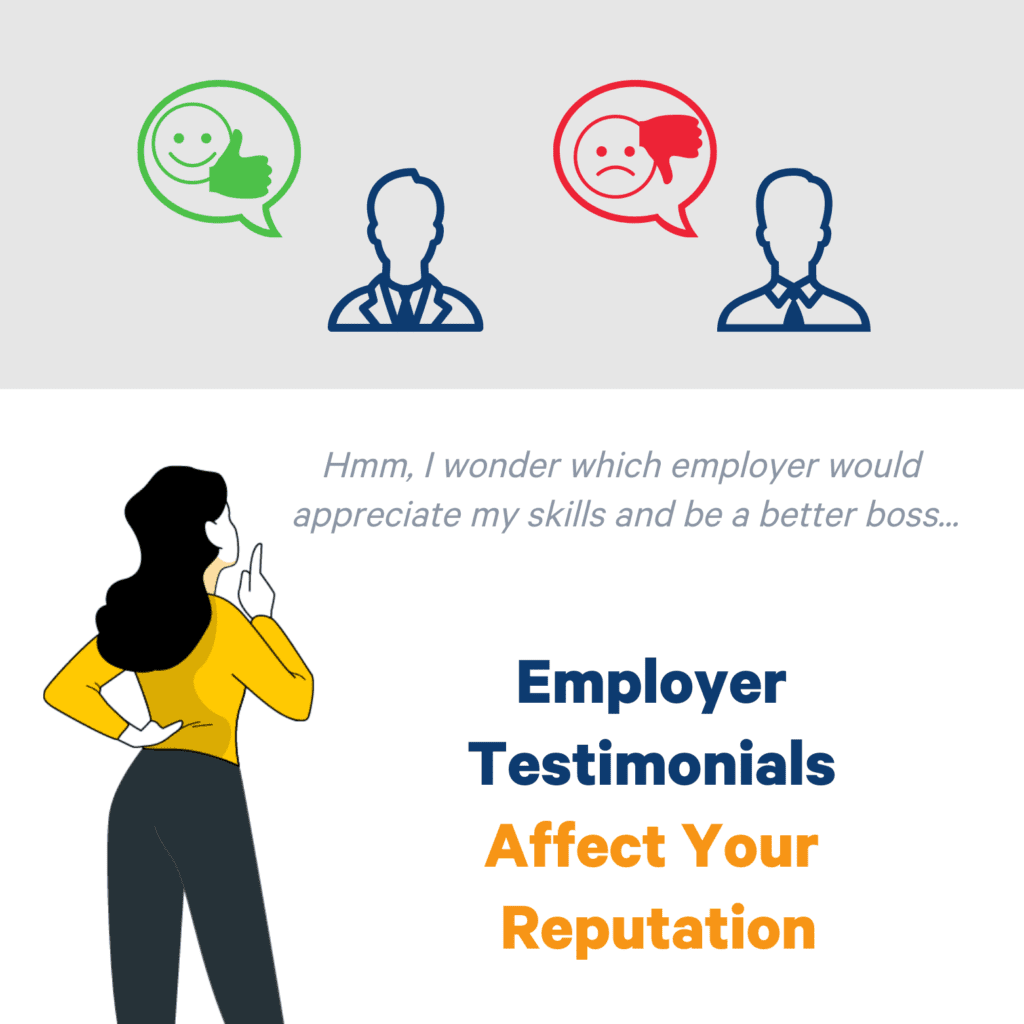
Start Collecting and Displaying Testimonials Automatically
Getting testimonials from customers can feel like a daunting task if you're starting from scratch. However, with the right tool, you can automate the whole process and keep getting new testimonials continuously.
With Trustmary, you can get testimonials with a highly effective feedback method. With the 3-in1 survey, you can:
- Measure customer satisfaction
- Collect constructive feedback
- Get reviews and testimonials
Integrate Trustmary with your CRM and other daily tools to make the feedback and testimonial collection flow even more accurate and effective.
Additionally, we help you utilize the testimonials you collect: add them to website to enhance trust and boost SEO, share on social media, or embed in your sales materials.
Test out the free version or book a free meeting with us to hear more.
FAQ on Testimonials
Do testimonials improve conversion rates on websites?
Yes, as long as the testimonials are relevant. Testimonials have the potential to multiply your website conversion rates and they perform well on average. Don't throw just any testimonial on a random page: analyze the context.
For what kinds of businesses do testimonials work the best?
All types, regardless of the industry the company is in. The key is to use different types of testimonials for each business and in different use cases.
Use:
- short, casual testimonials (text or video) for low-price B2C sales
- polished, well-produced video testimonials for high-price B2C or B2B sales
- long, detailed case studies for B2B clients (these may feature text, video, photos, graphics etc.)
How much does creating a testimonial cost?
Anything from zero to thousands per testimonial. It depends on what you’re looking for.
- Zero if you collect existing testimonials from social media, review platforms, emails etc.
- Pennies if you use dedicated testimonial software
- Potentially thousands and more if you hire a professional videographer to create a video testimonial (sometimes it's worth it!)
Learn how to set up a testimonial generator for getting authentic customer testimonials!
Are testimonial pages worth creating?
Yes, because they provide your possible future customers with the proof that your company can be trusted. It'll help improve conversion rates.
However, you should consider using testimonial widgets to increase trust all over your website. The more your potential customers see what the previous customers have thought about you, the more likely they are to buy from you too.
How can I get quote testimonials?
You probably have them already in Google, Facebook and other third party review softwares. You can use Trustmary to import them and to display customer testimonials on your website either with social proof widgets or by having a dedicated testimonial page.
With Trustmary, you can also collect new customer testimonials.
